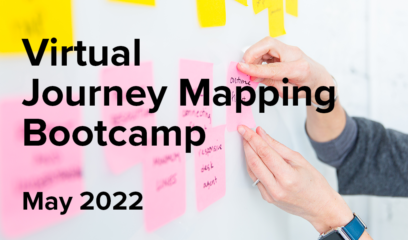Imagine you’re in the midst of a journey mapping workshop and your customers are bombarding you—in a good way—with insights about their needs and expectations.
Somewhere along the way, a participant recounts a particularly bad experience, and you feel compelled to explain the behind-the-scenes factors that derailed her experience.
“Well, that’s because of a regulation we don’t have control over,” you begin to say. Or perhaps a participant shares an experience that runs counter to what you know to be true. “Well that can’t be right. Our maximum appointment window is two hours, so there’s no way you waited six.”
And before you know it, you’re doing all the talking. Don’t fall into this trap, as we’ve seen some past clients do. (Yes, the examples above are real.) And sure, explaining or contradicting your customers isn’t truly evil, but it’s certainly counterproductive to unlocking customer insights.
Here’s why:
It wastes time.
You’ll make the most of precious workshop time if the flow of information is primarily from customers to you. A defensive treatise on the rationale behind an inconvenient experience is an invitation into a time-consuming rabbit hole. In the (unlikely) event that a participant displays more than a passing interest in your organization’s internal workings, offer to discuss it with them during a break or to follow up after the workshop. We try to stick to the 80/20 rule, where customers in our workshops do 80% of the talking.
- Instead of: Ok, here’s why that happened…
- Try: That sounds frustrating—what did you do next? What were you expecting to happen instead?
It stifles ideas.
When customers are laying out their ideal experience, it’s not their job to understand your organization’s backstage intricacies and constraints. There may be any number of reasons why you can’t implement their brilliant plan—but you can hash that out with your colleagues later. Instead, dig for the insight behind the idea; what problem does it solve for customers? And even off-the-wall ideas might contain the seeds of innovative future solutions. Just make sure to set proper expectations about what you plan to do with customer feedback post-workshop.
- Instead of: There’s no way could we implement that with our legacy IT infrastructure.
- Try: Tell me more! What would that look like? Why would that be helpful?
It’s not about your reality—it’s about customers’ perceptions.
Maybe you DO send a plethora of onboarding emails. But if your customers aren’t getting the message(s), perhaps there’s an opportunity to structure these communications more effectively or to communicate via a different channel. Nothing squanders this opening faster than contradicting a customer’s memory or emotional response. Plus, it jeopardizes their willingness to share honest feedback.
- Instead of: We send several welcome emails. Maybe they went to your spam folder.
- Try: What information were you expecting, and how were you expecting to get it? What subject lines would make you more likely to open emails?
The advice above doesn’t mean you should be in observation-only mode during a workshop—the opportunity for co-creation with customers is a signature benefit of this research method. So by all means, ask questions and bounce your ideas off of participants for reactions and improvements. But never contradict your customers, make sure your explanations are on a need-to-know basis, and save your internal conversations for a later date.




